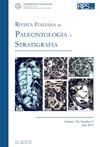EOMYIDS FROM THE RIBESALBES-ALCORA BASIN (EARLY MIOCENE, IBERIAN PENINSULA) AND THEIR BIOSTRATIGRAPHIC AND PALAEOECOLOGICAL IMPLICATIONS.
IF 1.9
3区 地球科学
Q2 GEOLOGY
引用次数: 4
Abstract
Two species of the family Eomyidae are identified in the Early Miocene localities of the Araia d’Alcora outcrop (Ribesalbes-Alcora Basin, Iberian Peninsula): Ligerimys florancei and Ligerimys ellipticus. The first is rarer than the second, which is one of the most abundant mammals in the Ribesalbes-Alcora Basin assemblages. Due to its abundance, we are able to describe its variability in dental morphology, showing characteristics never previously observed, including the presence of a mesoloph or other features previously described only in ancient assemblages of this species, such as the presence of the anteroloph, which appears in younger assemblages in the Araia sequence. Furthermore, based on the eomyids, we divide the record of the Campisano Ravine section into two long local biozones, depending on the species present. In addition, each local biozone is divided into two smaller sub-biozones, depending on the abundance of each species. We retrospectively compare and correlate the assemblages studied here with other Ligerimys assemblages from the other basins in the Iberian Peninsula. We classify these sites based on the abundance and species of the genus Ligerimys. Additionally, we discuss the palaeoecological preferences of these species里贝萨尔贝斯阿尔科拉盆地(中新世早期,伊比利亚半岛)的EOMYIDS及其生物地层学和古生态意义。
在Araia d’Alcora露头的早中新世地区(伊比利亚半岛Ribesalbes Alcora盆地)发现了两种Eomyidae科物种:Ligermys florancei和LigerMys ellipticus。第一种比第二种更为罕见,第二种是Ribesalbes-Alcora盆地组合中数量最多的哺乳动物之一。由于其丰富性,我们能够描述其牙齿形态的可变性,显示出以前从未观察到的特征,包括中胚层的存在或以前仅在该物种的古代组合中描述的其他特征,例如前胚层的存在,它出现在Araia序列中较年轻的组合中。此外,根据eomyids,我们将Campisano Ravine剖面的记录划分为两个长的局部生物区,具体取决于存在的物种。此外,根据每个物种的丰度,每个局部生物区被划分为两个较小的亚生物区。我们将这里研究的组合与伊比利亚半岛其他盆地的其他Ligermys组合进行了回顾性比较和关联。我们根据Ligermys属的丰度和物种对这些地点进行分类。此外,我们还讨论了这些物种的古生态偏好
本文章由计算机程序翻译,如有差异,请以英文原文为准。
求助全文
约1分钟内获得全文
求助全文
来源期刊
CiteScore
3.60
自引率
4.30%
发文量
28
审稿时长
>12 weeks
期刊介绍:
The Rivista Italiana di Paleontologia e Stratigrafia was founded in 1895. It publishes original papers dealing with all fields of paleontology and of stratigraphy, from Italy and the Mediterranean to the Tethys, as well across the globe from China to North America.

 求助内容:
求助内容: 应助结果提醒方式:
应助结果提醒方式:


